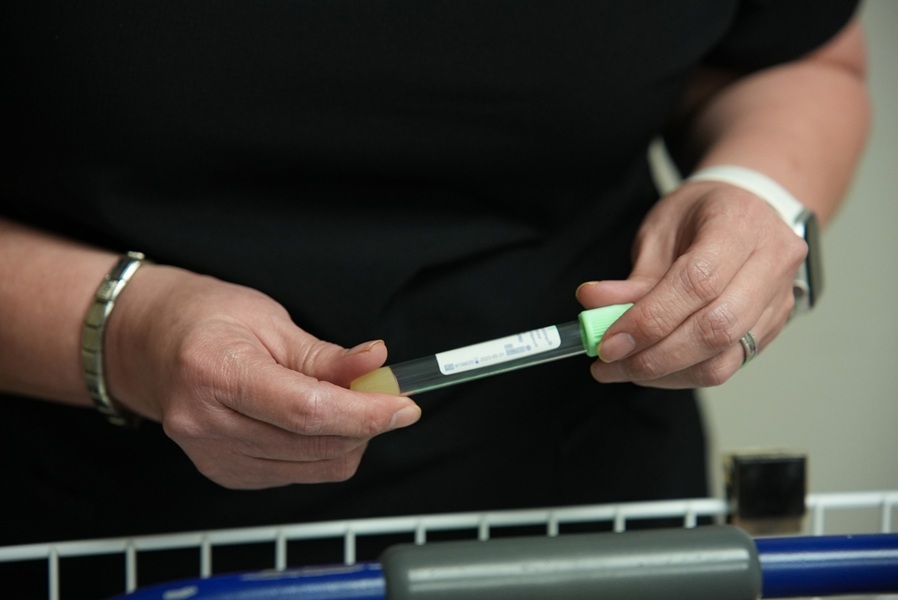Blood Test Could Detect Stroke Type Before Hospital Arrival
|
By HospiMedica International staff writers Posted on 31 Jan 2025 |

The longer the time between a stroke's onset and diagnosis, the greater the damage to brain tissue, which worsens the patient's prognosis. It's crucial to distinguish between a hemorrhagic (bleeding) stroke and an ischemic (clot-caused) stroke before initiating treatment, as this decision significantly affects the approach. Generally, this distinction is made using imaging techniques, which can be delayed as the patient is stabilized, transported to the emergency room, and then sent for a brain scan — all while brain cells continue to die. A new blood test may now allow for rapid differentiation between brain bleeds and clot-caused strokes, even before patients with stroke symptoms arrive at the emergency room, as indicated by a preliminary study presented at the American Stroke Association's International Stroke Conference in 2025.
Researchers at RKH Hospital Klinikum Ludwigsburg (Ludwigsburg, Germany) explored whether blood levels of glial fibrillary acidic protein (GFAP) could help quickly diagnose stroke types. GFAP is a protein specific to the brain, which is released into the bloodstream when brain cells are damaged or destroyed. This protein is already used to assess traumatic brain injuries. In a parallel study published in 2024, the research team demonstrated that GFAP levels could quickly distinguish between patients with a bleeding stroke and those who were unresponsive. The focus of this new study was to determine if GFAP levels could differentiate between hemorrhagic stroke (due to bleeding), ischemic stroke (caused by a blood clot), and conditions that mimic a stroke. Blood samples were collected by the emergency medical services ambulance team before the patients arrived at the hospital.
The analysis revealed that GFAP levels were nearly 7 times higher in patients with a bleeding stroke compared to those with a clot-caused stroke (208 picograms per milliliter, or pg/mL, vs. 30 pg/mL) and more than 4 times higher in bleeding stroke patients compared to those with stroke mimics (208 pg/mL vs. 48 pg/mL). The researchers were able to rule out a bleeding stroke in patients with moderate to severe neurological deficits if the GFAP levels were below 30 pg/mL. Additionally, when using age-based cut-off points, they achieved 90%-95% accuracy in predicting which patients had a bleeding stroke. These age-based groups were evenly distributed: under age 72, between 72 and 83, and above 83. Interestingly, the cutoff for those under age 72 was quite low. The researchers also found that GFAP levels were higher in bleeding stroke patients who were on blood thinners compared to those not using these medications. If these findings are confirmed through larger studies, early GFAP measurements could revolutionize the treatment of individuals with stroke symptoms.
“This study reveals that levels of GFAP, a marker for brain injury, are higher in patients with brain hemorrhages compared to those who have strokes caused by blood clots,” said American Heart Association expert volunteer Louise D. McCullough, M.D., P.H.D., FAHA. “This finding suggests that GFAP could serve as a useful prehospital test for assessing brain injuries. However, the study had a relatively small sample size, and for the test to be effective, both the patient's blood and the GFAP test must be available as a “point of care” test in the field. Currently, most ambulances and emergency medical services do not have access to this blood test.”
Related Links:
RKH Hospital Klinikum Ludwigsburg
Channels
Critical Care
view channel
AI-Powered, Internet-Connected Medical Devices to Revolutionize Healthcare, Finds Study
A new study suggests that artificial intelligence (AI)-powered, internet-connected medical devices have the potential to transform healthcare by enabling earlier detection of diseases, real-time patient... Read more
Starfish-Inspired Wearable Tech Enables Smarter Heart Monitoring
Physical movement can make it challenging for current wearable devices to accurately track heart activity. Now, a starfish’s five-arm shape has helped resolve this issue. Inspired by the starfish's ability... Read moreSurgical Techniques
view channel
New Transcatheter Valve Found Safe and Effective for Treating Aortic Regurgitation
Aortic regurgitation is a condition in which the aortic valve does not close properly, allowing blood to flow backward into the left ventricle. This results in decreased blood flow from the heart to the... Read more
Minimally Invasive Valve Repair Reduces Hospitalizations in Severe Tricuspid Regurgitation Patients
The tricuspid valve is one of the four heart valves, responsible for regulating blood flow from the right atrium (the heart's upper-right chamber) to the right ventricle (the lower-right chamber).... Read morePatient Care
view channel
Portable Biosensor Platform to Reduce Hospital-Acquired Infections
Approximately 4 million patients in the European Union acquire healthcare-associated infections (HAIs) or nosocomial infections each year, with around 37,000 deaths directly resulting from these infections,... Read moreFirst-Of-Its-Kind Portable Germicidal Light Technology Disinfects High-Touch Clinical Surfaces in Seconds
Reducing healthcare-acquired infections (HAIs) remains a pressing issue within global healthcare systems. In the United States alone, 1.7 million patients contract HAIs annually, leading to approximately... Read more
Surgical Capacity Optimization Solution Helps Hospitals Boost OR Utilization
An innovative solution has the capability to transform surgical capacity utilization by targeting the root cause of surgical block time inefficiencies. Fujitsu Limited’s (Tokyo, Japan) Surgical Capacity... Read more
Game-Changing Innovation in Surgical Instrument Sterilization Significantly Improves OR Throughput
A groundbreaking innovation enables hospitals to significantly improve instrument processing time and throughput in operating rooms (ORs) and sterile processing departments. Turbett Surgical, Inc.... Read moreHealth IT
view channel
Printable Molecule-Selective Nanoparticles Enable Mass Production of Wearable Biosensors
The future of medicine is likely to focus on the personalization of healthcare—understanding exactly what an individual requires and delivering the appropriate combination of nutrients, metabolites, and... Read more
Smartwatches Could Detect Congestive Heart Failure
Diagnosing congestive heart failure (CHF) typically requires expensive and time-consuming imaging techniques like echocardiography, also known as cardiac ultrasound. Previously, detecting CHF by analyzing... Read morePoint of Care
view channel
Handheld, Sound-Based Diagnostic System Delivers Bedside Blood Test Results in An Hour
Patients who go to a doctor for a blood test often have to contend with a needle and syringe, followed by a long wait—sometimes hours or even days—for lab results. Scientists have been working hard to... Read more
Smartphone-Enabled, Paper-Based Quantitative Diagnostic Platform Transforms POC Testing
Point-of-care diagnostics are crucial for public health, offering rapid, on-site testing that enables prompt diagnosis and treatment. This is especially valuable in remote or underserved regions where... Read moreBusiness
view channel
Expanded Collaboration to Transform OR Technology Through AI and Automation
The expansion of an existing collaboration between three leading companies aims to develop artificial intelligence (AI)-driven solutions for smart operating rooms with sophisticated monitoring and automation.... Read more




















